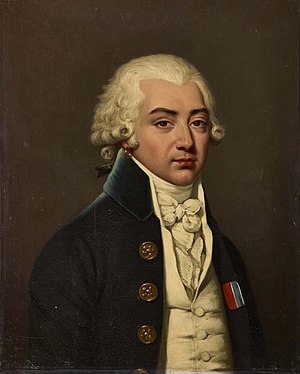Armand Louis de Gontaut
| Armand Louis de Gontaut | |
|---|---|

Armand Louis de Gontaut, Duc de Lauzun, and Duc de Biron
|
|
| Born |
13 April 1747 Paris |
| Died |
31 December 1793 (aged 46) Paris |
| Allegiance |
|
| Service/branch | French Army |
| Awards |
Order of Cincinnati Order of St. Louis |
Armand Louis de Gontaut, Duc de Lauzun, later duc de Biron, and usually referred to by historians of the French Revolution simply as Biron (13 April 1747 – 31 December 1793) was a French soldier and politician, known for the part he played in the American War of Independence and the French Revolutionary Wars. In 1773, he was Grand second warden of Grand Orient de France.
Born in Paris, he bore the title of Duc de Lauzun, which had passed, on the death of Antoine Nompar de Caumont, duc de Lauzun (1633–1723), to his niece, the wife of Charles Armand de Gontaut, duc de Biron (1663–1756). In 1788, he succeeded to the duchy of Biron on the death of his uncle, Louis Antoine de Gontaut, duc de Biron (1700–1788). He married Amelia de Boufflers, only daughter of Charles-Joseph de Boufflers (1731–1751) and Mary Anne Philippine de Montmorency Logny (1732–1797), a young woman described as a paragon a gentle, virginal shyness, a combination of shrewdness and simplicity. Similarly the Duke was a popular companion and house guest.
After, for a while, spending his fortune in various parts of Europe, he attracted attention by an essay on the military defences of Great Britain and her colonial empire (État de defense d'Angleterre et de toutes ses possessions dans les quatres parties du monde). This led to his appointment to a command against the British in 1779. In February he commanded the troops that captured Fort St Louis, in Senegal, from the British. After raising an army of volunteer hussars and infantry, subsequently known as Lauzun's Legion, for service in North America. He arrived with 600 of his men in Rhode Island; the remainder were in France, prevented from leaving. Despite having only a portion of his force, he engaged in several active skirmishes, including one near Gloucester, Virginia on 4 October 1781.
...
Wikipedia
